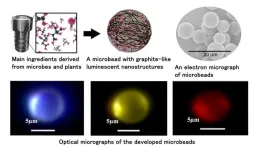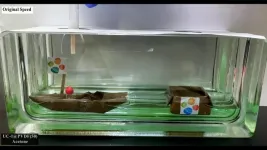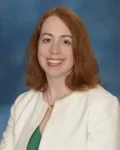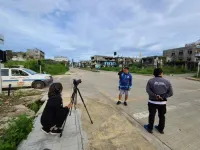Microbeads with adaptable fluorescent colors from visible light to near-infrared
Environmentally friendly luminescent material made mainly from plant-derived material
2024-07-12
(Press-News.org)
1. A research team at NIMS has successfully developed an environmentally friendly, microspherical fluorescent material primarily made from citric acid. These microbeads emit various colors of light depending on the illuminating light and the size of the beads, which suggests a wide range of applications. Furthermore, the use of plant-derived materials allows for low-cost and energy-efficient synthesis.
2. Conventional luminescent devices commonly utilized thin films of compound semiconductors containing metals or sintered inorganic materials with rare earth elements. However, in a circular economy, there is a demand for fluorescent/luminescent materials that do not use rare earth elements, which have unstable supply chains, or metal elements with significant environmental impact. The microbeads we developed aim to provide low-environmental-impact fluorescent materials using abundant, easily obtainable plant-derived materials as the main ingredients.
3. The research team, led by the Nano-Photonics Group at the Research Center for Materials Nanoarchitectonics (MANA), developed microbead-type luminescent materials synthesized by heating citric acid and polyamino acids, which are used in soft drinks and food additives. These spheres utilize the fluorescence from soot- or graphite-like nanostructures within the heat-denatured, aggregated polyamino acids to emit red, blue, and yellow light, as well as near-infrared light invisible to the naked eye. By leveraging the light confinement effect of the microbeads, they have demonstrated that a single bead can emit various colors of light (different wavelengths of light).
4. In addition to emitting various colors of light, the fluorescence wavelength and light intensity distribution (fluorescence spectrum) of these microbeads vary significantly according to their shape and size. These unique fluorescence spectra for each bead can be used like authentication tags or barcodes. This capability allows for identifying individual beads using light, leading to applications such as color-changing paints, anti-counterfeit inks, and fluorescent probes that can identify and track individual beads in biological systems.
***
5. This research was conducted by a team consisting of Tadaaki Nagao, Group Leader of the Photonics Nano-Engineering Group at MANA, NIMS Postdoctoral Researcher Barun Kumar Barman (formerly a JSPS Postdoctoral Fellow), JSPS Research Fellow Hiroyuki Yamada, Researcher Keisuke Watanabe, Atsushi Goto, Group Leader of the Solid-State NMR Group at the Center for Basic Research on Materials, Principal Researcher Kenjiro Hashi, Principal Engineer Shinobu Ohki, and Engineer Kenzo Deguchi from the High Magnetic Field Characterization Unit of the Research Network and Facility Services Division at NIMS. This research was supported by a grant from the Japan Society for the Promotion of Science (JSPS).
6. The results of this research will be published in the June 13, 2024, online issue of the journal Advanced Science.
END
[Attachments] See images for this press release:

ELSE PRESS RELEASES FROM THIS DATE:
2024-07-12
About The Study: In this cross-sectional study, the expression of several stress-related genes in prostate tumors was higher among men residing in disadvantaged neighborhoods. This study is one of the first to suggest associations of neighborhood disadvantage with prostate tumor RNA expression. Additional research is needed in larger studies to replicate findings and further investigate interrelationships of neighborhood factors, tumor biology, and aggressive prostate cancer to inform interventions to reduce disparities.
Corresponding Author: To contact the corresponding author, ...
2024-07-12
About The Study: This secondary analysis of a randomized clinical trial found that a short-term reduction in leisure-time screen media use within families positively affected psychological symptoms of children and adolescents, particularly by mitigating internalizing behavioral issues and enhancing prosocial behavior. More research is needed to confirm whether these effects are sustainable in the long term.
Corresponding Author: To contact the corresponding author, Jesper Schmidt-Persson, Ph.D., email jesp@kp.dk.
To ...
2024-07-12
About The Study: The findings of this study suggest that Mediterranean diet-based interventions may be useful tools to optimize cardiometabolic health among children and adolescents.
Corresponding Author: To contact the corresponding author, Jose Francisco Lopez-Gil, Ph.D., email josefranciscolopezgil@gmail.com.
To access the embargoed study: Visit our For The Media website at this link https://media.jamanetwork.com/
(doi:10.1001/jamanetworkopen.2024.21976)
Editor’s Note: Please see the article for additional information, including other authors, author contributions ...
2024-07-12
Scientists at King Abdullah University of Science and Technology (KAUST) in Saudi Arabia have developed a tiny “claw machine” that is able to pick up and drop a marble-sized ball in response to exposure to chemical vapors.
The findings, published July 12 in the journal Chem, point to a technique that can enable soft actuators—the parts of a machine that make it move—to perform multiple tasks without the need for additional costly materials. While existing soft actuators can be “one-trick ponies” restricted to one type of movement, this novel composite film contorts itself ...
2024-07-12
BALTIMORE, MD, July 12, 2024 — Those living in disadvantaged neighborhoods have significantly higher activity of stress-related genes, new research suggests, which could contribute to higher rates of aggressive prostate cancer in African American men. The study, which was co-led by the University of Maryland School of Medicine (UMSOM) and Virginia Commonwealth University (VCU), was published today in JAMA Network Open.
African American men have a higher incidence of prostate cancer and are more than twice as likely to die from the disease than White men in the U.S. They are often diagnosed with an ...
2024-07-12
Overview:
DNA aptamers of melanopsin that regulate the clock hands of biological rhythms were developed by the Toyohashi University of Technology and the National Institute of Advanced Industrial Science and Technology (AIST) group.
DNA aptamers can specifically bind to biomolecules to modify their function, potentially making them ideal oligonucleotide therapeutics. We screened the DNA aptamer melanopsin (OPN4), a blue light photopigment in the retina that plays a key role in the use of light signals to reset the phase of circadian rhythms in the central clock.
First, 15 DNA aptamers of melanopsin (Melapts) were identified following eight rounds of Cell-SELEX ...
2024-07-12
Wars and conflicts leave devastating destruction in their wake. With so many conflicts now taking place in urban environments, scientists are studying how post-conflict peacebuilding happens in these urban settings. Dahlia Simangan, an associate professor at The IDEC Institute, Hiroshima University, has analyzed the case of Marawi, a city in the Philippines, to better understand the urban environment’s influence on post-siege reconstruction and peacebuilding. This study contributes to a more comprehensive understanding of peacebuilding by integrating conventional peacebuilding components and urban characteristics.
The findings are published ...
2024-07-12
Osaka, Japan – From LEDs to batteries, our lives are full of electronics, and there is a constant push to make them more efficient and reliable. But as components become increasingly sophisticated, getting reliable temperature measurements of specific elements inside an object can be a challenge.
This is problematic because measuring a device’s temperature is vital for monitoring its performance or designing the materials from which it’s manufactured. Now, in a new study led by Osaka ...
2024-07-12
High and low tide cause low and high methane fluxes
Methane, a strong greenhouse gas that naturally escapes from the bottom of the North Sea, is affected by the pressure of high or low tide. Methane emissions from the seafloor can be just easily three times as much or as little, depending on the tide. This is shown by NIOZ oceanographer Tim de Groot, in a publication in Nature Communications Earth and Environment. "Our research shows that you can never rely on one measurement when you want to know how much methane escapes from the seafloor," De Groot emphasizes.
Swamp ...
2024-07-12
While the COVID-19 vaccines introduced many people to RNA-based medicines, RNA oligonucleotides have already been on the market for years to treat diseases like Duchenne Muscular Dystrophy and amyloidosis. RNA therapies offer many advantages over traditional small molecule drugs, including their ability to address almost any genetic component within cells and to guide gene editing tools like CRISPR to their targets.
However, the promise of RNA is currently limited by the fact that rapidly growing global demand is outpacing the industry’s ability to manufacture it. The standard method of chemically ...
LAST 30 PRESS RELEASES:
[Press-News.org] Microbeads with adaptable fluorescent colors from visible light to near-infrared
Environmentally friendly luminescent material made mainly from plant-derived material





